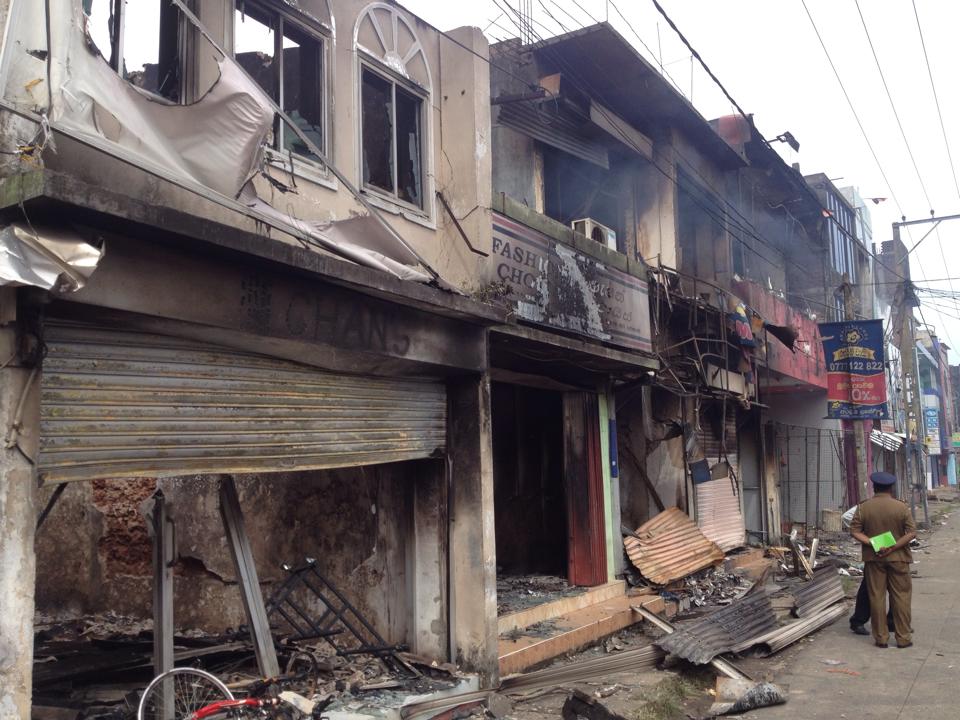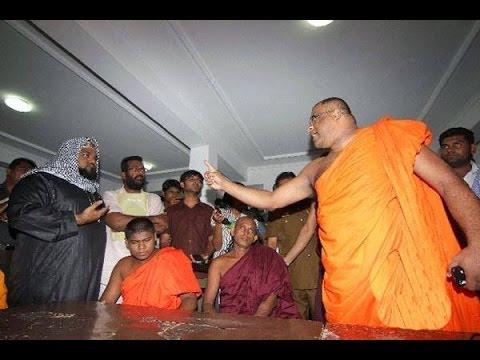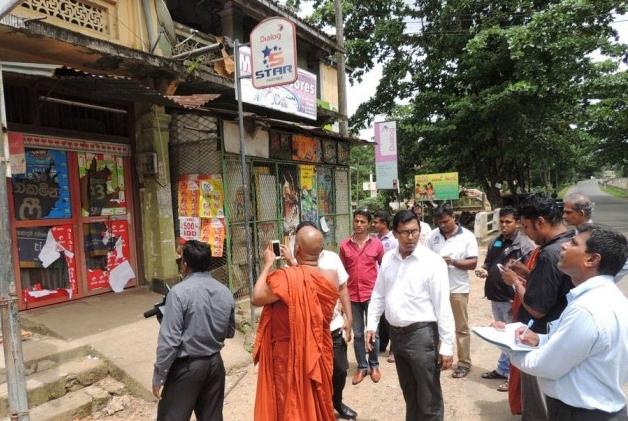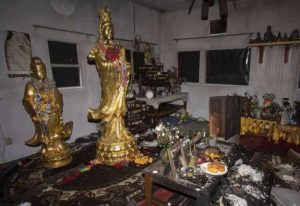I met Mawlavi Faiz, the chief caretaker and Imam of the Red Mosque in Kandy, on his way out after the evening prayers. On being asked his reaction to recent events in the southern towns of Aluthgama and nearby Dharga in Sri Lanka, his mood was somber and his expression thoughtful. The intense clashes between the majority Sinhala Buddhists and Muslims took four lives and chalked up yet another black mark for Sri Lankan post-colonial history. “We are still hurt as a community by what happened,” Mawlavi Faiz explained. “The Muslims of Sri Lanka are never prone to violence. Yet, this time things got out of hand. In Tamil language there is a saying which goes, ‘A physical wound easily heals, yet an emotional wound never does.’ This indeed is an emotional wound which exists within the community mindset of Sri Lankan Muslims. We really must ensure a repetition of this nature never takes place.”
The incidents in the south erupted on 12 June 2014, when Venerable Ayagama Samitha and his driver, of Sri Wijayaramaya Buddhist temple in Kurunduwatta, were allegedly attacked by two Muslim youths while driving along a narrow street. Apparently, the street was blocked by the youths’ motorcycle, which the driver asked them to move. The subsequent tension rapidly escalated, with both Sinhalese Buddhists and Muslims attacking each other and damaging property. The Buddhists blamed pockets of extremist Muslim fundamentalists, while the Muslims blamed the equally extreme Nationalistic Buddhist group Bodu Bala Sena (BBS). The BBS have often voiced displeasure at the rising Islamic extremism in Sri Lanka, and following the incident, its chief executive Dilantha Withanage commented in the Daily Financial Times: “The Bodu Bala Sena was never involved in any violent activities and we will never approve of such moves. We are trying to warn the people that in another decade or two there will be clashes between religious groups in the country. Unfortunately, it is happening right now in front of our very eyes.” Despite the BBS allegations of Muslim conspiracies and atrocities, Mawlavi Faiz claims that “Muslims would never be the first to throw a stone.”
In fact, the history of Arab presence in Sri Lanka dates back to the time of King Pandukabhaya (r. 437–367 BCE), when the Mahavamsa, the great Sri Lankan chronicle, indicates that the king gave land to Arabs who visited his capital for trade purposes. By the 9th century, they had gained a strong foothold on the island, forming trade communities around coastal areas like Beruwala and Hambanthota. Additionally, although it is omitted from the Mahavamsa, the Arabian explorer Ibn Battuta claims in his memoirs to have met a regional Muslim ruler named Jalasthi in a coastal city called Kolanbu (present-day Colombo) who had five hundred Abyssinian soldiers serving him (Battuta 1997, 260). This would indicate that the prevailing Sinhalese Buddhist history downplays the presence of Muslim communities within Sri Lanka by purposefully omitting certain segments. Such a de-emphasis of the importance of their ethnic presence in Sri Lanka has also been a barrier to peaceful co-existence between the island’s Muslims and Sinhala Buddhists.
Sri Lanka has a deeply rooted, ethnicity-based ideology, which over the years has given rise to considerable tension and conflict between its three nationalities, namely the Sinhalese, Tamils, and Muslims. We are in fact still healing our wounds from the 30-year civil war that raged between the separatist Tamil guerrilla group LTTE and the majority Sinhalese, culminating in an approximate death toll of 60,000. Despite the loss of life and communal peace, the reconciliation process within Sri Lanka seems slow to take root. The Lessons Learnt and Reconciliation Commission (LLRC), which was appointed in 2010 by the UPFA (United People’s Freedom Alliance) government to ameliorate the tensions and eradicate the chance of further such escalations, did not succeed in its purpose. Its questionable procrastination has been frowned upon by the international community as well as by Tamils who lost family members under suspicious circumstances. The ethnic minorities would now appear to have lost faith in the reconciliation and rehabilitation processes organized by the majority Sinhala Buddhist government.
“I don’t believe the reconciliation took place in the way the Muslim community expected after the incidents in Aluthgama,” said Mawlavi Fawzer in a disappointed tone, during a telephone interview. Mawlavi Fawzer had been an advisor on Muslim affairs for President Mahinda Rajapaksa of the UPFA, who was recently defeated by the opposition candidate. It was widely speculated that the Muslim community would vote against him as they believed that the racial unrest was ignited by the then ruling party using Buddhist fundamentalist groups such as the BBS. “The Muslims of the area sustained lot of psychological trauma as well as financial loss due to these incidences. Even though the government declared relief work and aid for their benefit, it didn’t occur in the way it was planned. I think the first part of the reconciliation process is to rebuild the lifestyles and living standards of those who lost what they had. Afterwards, inter-religious and inter-community relationships can be rebuilt.” An investigation conducted by the Colombo Telegraph revealed the true state of the damage sustained by both parties. The statistics confirmed 4 deaths, over 200 incidents of damage to private property, and attacks on 17 mosques, with 2,248 families displaced (Colombo Telegraph).
A Buddhist monk who resides in Sri Wimalarama temple in Dharga was right in the middle of the clashes when they occurred: “Both parties sustained heavy damages to their physical properties, like buildings,” he told me. “However, the government was quick to resuscitate the Muslim community compared to the assistance received by Sinhala Buddhist community. The engineering corps of the Sri Lankan army successfully carried out the reconstruction work in the affected areas. In fact, one of the Mosques which were attacked even issued a statement expressing gratitude on the help given by the government. So now they are happy but we as Sinhala Buddhists of the area are not. Either way, we are not sure how long this peace will prevail. It’s the nature of this area and we do not know when we will also be attacked by Muslims.” The village of Pathirajagoda was a locus of the attacks. According to a villager, Ms. Sumudu, a total of six Sinhalese households were burned by a Muslim mob: “We all got along very well in this village but after these incidents, there is only suspicion in our minds,” she commented (Ceylon Today).




Reconciliation is a process of trust. While the seeds of mistrust exist between two ethnic communities, there can be no permanent peace. In the case of Sri Lanka, it is important for both Sinhalese and Muslims to consider the present situation in retrospect. Sinhala Buddhists must develop a certain level of trust in the Muslim community so that every Muslim is not looked upon as a threat. It is also important to acknowledge the historical presence of the entity called the “Sri Lankan Muslim” so that they will not be viewed as a population of invasion. On the other hand, the Muslim community should also respect the Sinhala Buddhists, their beliefs and culture, as it is apparent that without the religious tolerance exercised by the ancient Sri Lankans, the Muslims would have found it impossible to settle in Sri Lanka successfully. Sri Lanka has always been open to different nationalities and religions other than Buddhism, even though the present extremist Buddhist groups greatly disgrace these past characteristics of the island.
The way forward is to move from ethnic reconciliation to a national reconciliation, in which all three nationalities would be able to join in a process of sustainable peace. John Borneman, professor of Anthropology at Princeton University, puts forward a simple definition of reconciliation: “Reconciliation I define not in terms of permanent peace or harmony but as a project of departure from violence” (Borneman 2002). Such a departure from violence seems an immediate possibility and a necessity for Sri Lankan ethnic groups while the groundwork is laid for a better tomorrow.
References
Battuta, Ibn. 1997. Travels in Asia and Africa. New Delhi: Asian Educational Services.
Borneman, John. 2002. “Reconciliation after Ethnic Cleansing: Listening, Retribution, Affiliation.” http://muse.jhu.edu/journals/pc/summary/v014/14.2borneman.html.
De Silvas, A. D. K. M. 1977. Historical Survey, Sri Lanka – A Survey. London: C. Hurst & Co. Ltd.
Imtiaz, Zahrah. 2014. “Mutual Fear and Suspicion between Muslims and Sinhalese as Aluthgama Struggles to Rise From Rubble and Ashes.” http://dbsjeyaraj.com/dbsj/archives/31618.
Van Sanden, J. C. 1925. Sonahar. A brief history of the Moors of Ceylon. Daily Mail Press.
Yogasundaram, N. 2008. A Comprehensive History of Sri Lanka. Colombo: Vijitha Yapa.
For more information, see:
Video: Aluthgama Sinhala Victims (Colombo Telegraph)
BBS speaks out on Aluthgama aftermath (Daily Financial Times)
Fear and suspicion abound in Aluthgama Even as the Army rebuilds (Ceylon Today)






